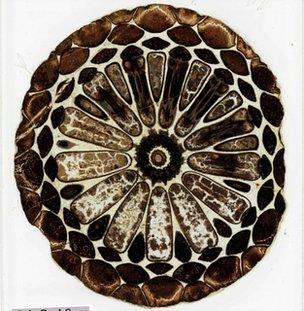Lost Charles Darwin fossils rediscovered in cabinet
- Published

The fossil plants are polished into thin, translucent sheets
A "treasure trove" of fossils - including some collected by Charles Darwin - has been re-discovered in an old cabinet.
The fossils, lost for some 165 years, were found by chance in the vaults of the British Geological Survey HQ near Keyworth, UK.
They have now been photographed and are available to the public through a new online museum exhibit released today.
The find was made by the palaeontologist Dr Howard Falcon-Lang.
Dr Falcon-Lang, who is based in the department of earth sciences at Royal Holloway, University of London, spotted some drawers in a cabinet marked "unregistered fossil plants".
"Inside the drawer were hundreds of beautiful glass slides made by polishing fossil plants into thin translucent sheets," Dr Falcon-Lang explained.
"This process allows them to be studied under the microscope. Almost the first slide I picked up was labelled 'C. Darwin Esq'."
"I had to pinch myself": Dr Falcon-Lang on BBC World Service
The item turned out to be a piece of fossil wood collected by Darwin during his famous Voyage of the Beagle in 1834. This was the expedition on which he first started to develop his theory of evolution.
In the course of his visit to Chiloe Island, Chile, Darwin encountered "many fragments of black lignite and silicified and pyritous wood, often embedded close together".
He had these shipped back to England where they were cut and ground into thin sections.
Joseph Hooker, a botanist and a close friend of Darwin, was responsible for assembling the "lost" collection while he briefly worked for the British Geological Survey in 1846.
The fossils became "lost" because Hooker failed to number them in the formal specimen register before setting out on an expedition to the Himalayas.
The collection was moved several times and gradually became forgotten.
Dr John Ludden, executive director of the Geological Survey said: "This is quite a remarkable discovery. It really makes one wonder what else might be hiding in our collections."
- Published1 September 2010